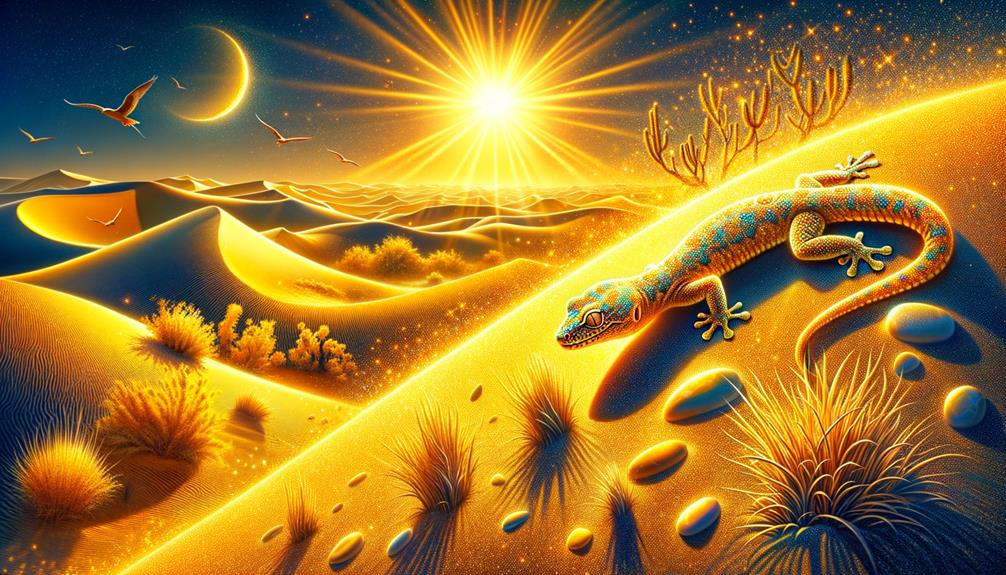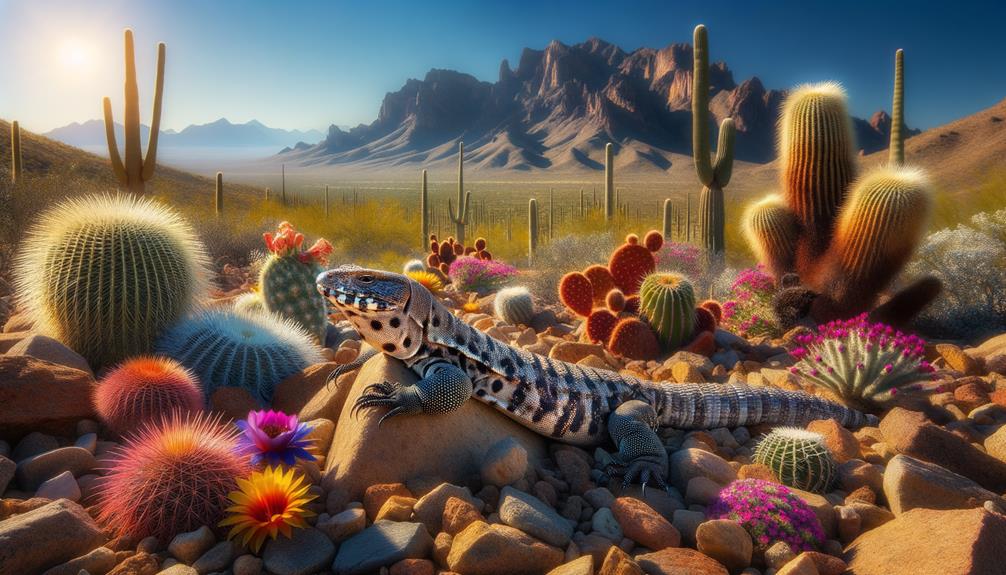During a trek in Central Australia, I spotted a bearded dragon sunbathing on a rock, looking like a guard watching over its dry domain. These tough lizards thrive in the sparse bush and grasslands, showing how well they've adapted to the harsh environment. Their sturdy build and range of colours, from dull browns to bright oranges, make them easy to spot. They eat both plants and bugs, and show some interesting social behaviours like fighting for territory. But these iconic creatures face big challenges from urban sprawl, predators, and people who want them as pets. So, how can we help make sure these lizards keep living and breeding in the wild where they belong?
Distribution and Habitat
Central Bearded Dragons call the dry inland areas of eastern Australia home. You'll find them in places like western New South Wales and the Riverina, where they thrive in sparse woodlands and grasslands. These hardy reptiles are adaptable, often seen perched on stumps, rocks, or fence posts in grazing areas. They're smart about it too – these high spots give them a good view to spot threats or potential meals.
But life's not all rosy for these lizards. Their homes are under threat. As farms expand and cities grow, the dragons are losing ground. The balance in their environment is shifting, leaving them with fewer safe spaces. The woodlands they depend on are being chopped up, making it harder for them to find food and shelter.
If we want to keep these tough little creatures around, we need to tackle these issues head-on. Protecting and fixing up their habitats is key. By getting to grips with what they need and how our actions affect them, we can take steps to keep their homes intact. It's about making sure these resilient reptiles have a fighting chance in the wild.
Physical Characteristics
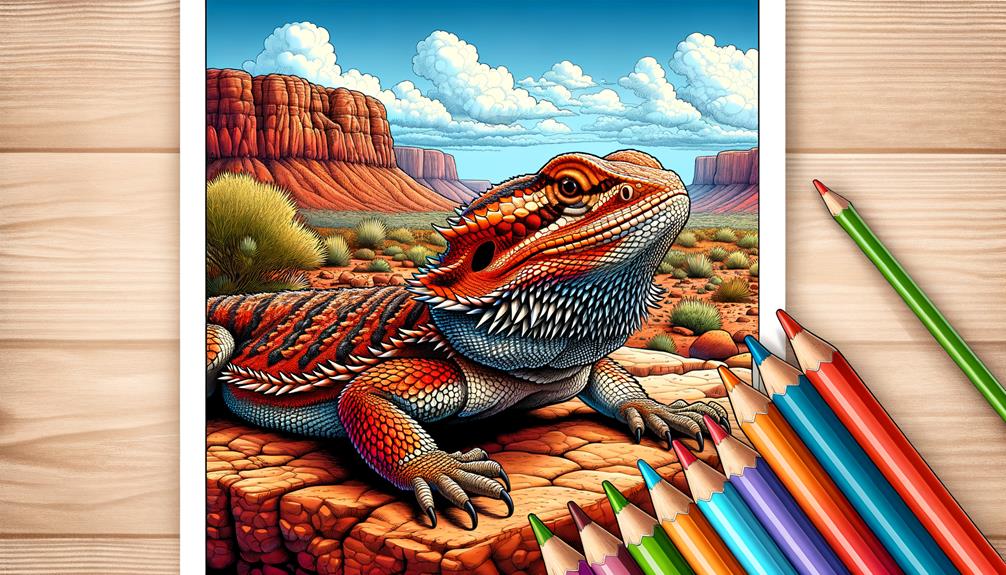
Central Australian bearded dragons are known for their sturdy build and distinctive spiky appearance. These lizards, which can grow up to 60cm long, have spines running from their throat to their tail. Their compact, robust bodies are well-suited to the harsh conditions of their arid woodland habitat.
These reptiles come in a range of colors, including various shades of brown, red, yellow, white, and orange. This diverse coloration helps them blend into their surroundings, offering protection from predators and an advantage when hunting prey. Male bearded dragons typically have darker beards than females, a feature that becomes more pronounced during mating season and plays a key role in their communication and courtship behaviors.
The entire body of a bearded dragon is covered in scales and spines, giving them a rugged appearance that hints at their ancient lineage. These physical characteristics serve multiple purposes, including defense, temperature regulation, and social interaction.
Their unique appearance and adaptations make bearded dragons fascinating subjects for both casual observers and reptile enthusiasts. As residents of central Australia's challenging environment, these lizards have evolved remarkable traits that allow them to thrive in conditions where many other species would struggle.
Diet and Nutrition
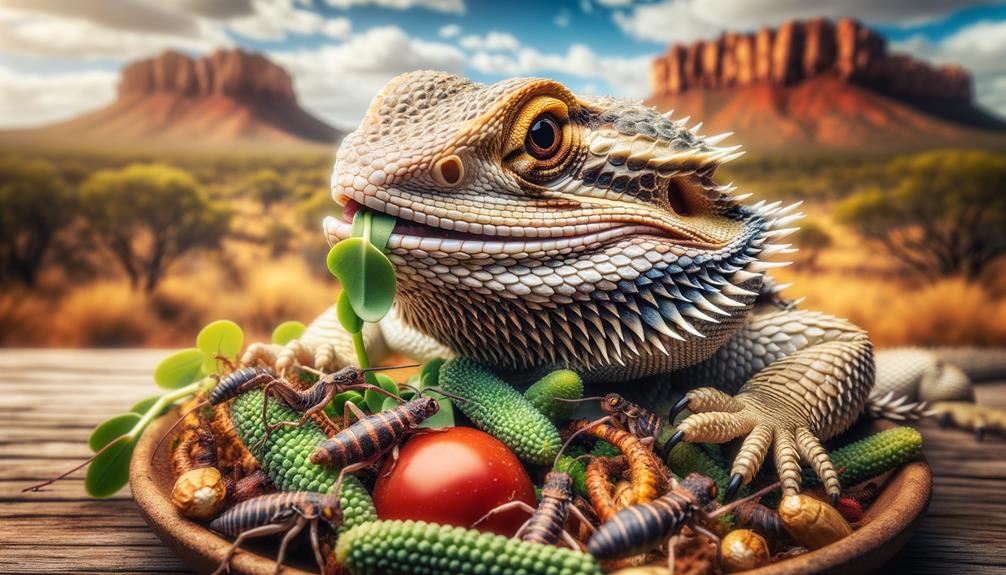
Central Australia's harsh landscape is home to some tough lizards. Bearded dragons thrive there, thanks to their knack for eating just about anything. These reptiles munch on a mix of plants and bugs, adapting their diet to what's available.
Their menu is diverse: flowers, leaves, and the odd small animal or egg. This varied fare keeps them healthy in their dry habitat. Insects are a big part of their diet, providing much-needed protein. Beetles, grasshoppers, and flying termites are all fair game. The dragons' taste for yellow flowers and their bug-hunting skills show how well they've adapted to their environment.
These lizards don't stop at plants and insects, though. They'll also snack on spiders, snails, and worms. This flexibility is key to their survival. By eating both plants and animals, bearded dragons get all the nutrients they need to stay strong in Australia's challenging outback.
Their ability to eat such a wide range of foods is impressive. It's not just about filling their bellies; it's about getting the right mix of vitamins, minerals, and proteins. This balanced diet is what allows them to thrive where other animals might struggle.
In the end, it's the bearded dragon's adaptable eating habits that make it so successful. They're not picky eaters, and that's exactly what they need to be to survive in the tough Australian wilderness.
Behaviors and Social Structure
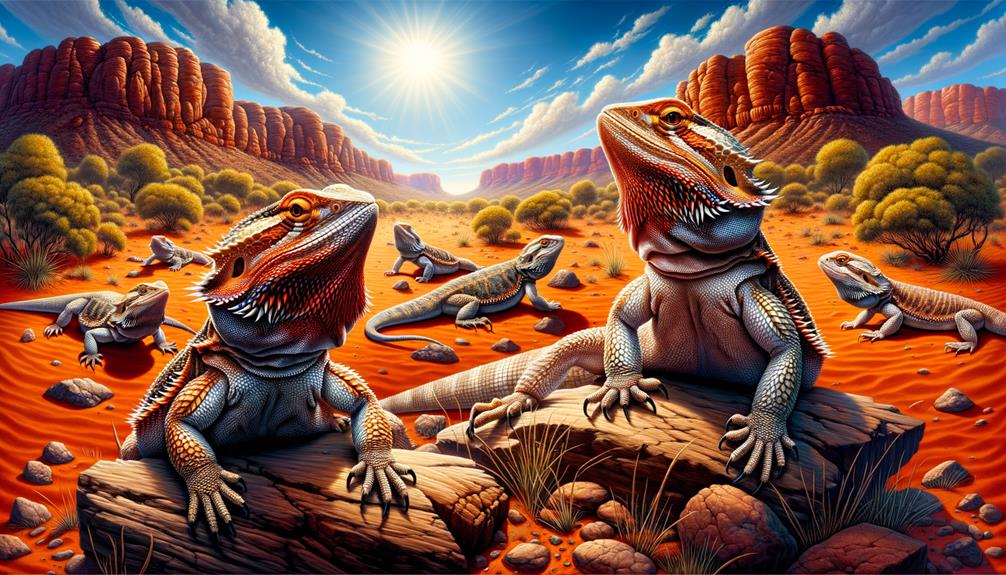
Central Bearded Dragons show off some interesting social behavior. Males often puff up and bob their heads quickly to show who's boss, usually from high spots. This creates a pecking order in their groups. Females and younger dragons wave their front legs to show they're not trying to challenge anyone. Watching these lizards interact gives us a glimpse into their complex social world. It's fascinating to see how they communicate without words, using body language to sort out who's in charge and who's not. These displays and signals help keep things organized in their little dragon societies.
Territorial Display Patterns
Male Central Bearded Dragons show who's boss through eye-catching moves like bobbing their heads and puffing out their beards, especially when it's time to find a mate. These showy behaviors help set the pecking order and warn off other males. When a male dragon wants to rule the roost, he'll climb up on a stump or rock, rapidly nod his head, and puff out his beard. His beard gets darker, signaling he means business. This isn't just for show – it's a clear "back off" to other males and a "come hither" to females.
Females and young dragons, on the other hand, play it cool with slower head nods and a unique wave of their front legs. This helps them avoid nasty fights. When scared, these lizards will press themselves flat against the ground and puff out their spiky necks, trying to look bigger and scarier.
Key behaviors:
- Quick head bobs from high spots
- Dark, puffy beards to show dominance
- Slow head nods and leg waves to show they're not looking for trouble
- Flattening out when scared
- Using high spots to survey their turf and show off
Knowing these behaviors helps us see how complex their social world is and why these displays matter so much in the wild.
Hierarchy and Dominance
Central Bearded Dragons have a fascinating social structure that influences their daily lives and survival tactics. During mating season, top-ranking males show off through head bobbing and beard flaring. These displays aren't just for show – they're crucial for defending territory and establishing pecking orders.
A quick guide to dragon body language:
- Fast head bobbing: Aggressive power move
- Puffed-up, dark throat: Intimidation tactic
- Slow head nods: Submissive gesture, often seen in females and youngsters
Lower-ranking dragons, including females and juveniles, use slow head nods and arm waves to show respect to the big bosses. When things get tense, these underdogs might flatten out and puff up their spiky throats as a defense move. The head honchos often perch high up, bobbing their heads rapidly to mark their turf.
Getting a handle on these power plays and social dynamics is key for scientists studying these intriguing creatures. It sheds light on how they survive and interact, showing the delicate balance of authority and submission in their natural homes.
Social Interaction Dynamics
Central Bearded Dragons live fascinating social lives, with their interactions shaped by a pecking order that influences their daily routines. These lizards show off a range of social behaviors that help establish and maintain their group dynamics.
Come breeding season, male dragons turn up the aggression. They puff out their beards and bob their heads to show who's boss and catch the eye of potential mates. It's a tense time, with males squabbling over territory as they vie for breeding rights. Females, on the other hand, often try to keep the peace. They'll wave their front legs as a way to say, "I'm not here to cause trouble."
In their day-to-day lives, these dragons often hang out in casual groups called lounges, soaking up the sun together. These gatherings play a big role in how they communicate and sort out who's who in their social circle.
Some key behaviors to watch for:
- Males bob their heads to mark their turf and show dominance.
- During mating season, males puff out their beards to look tough.
- Females wave their front legs to avoid confrontations.
- Dragons form lounges for basking and socializing.
- Males often get into spats, especially over territory.
Getting a grip on these social quirks helps us appreciate the complex world of Central Bearded Dragons.
Reproduction and Mating
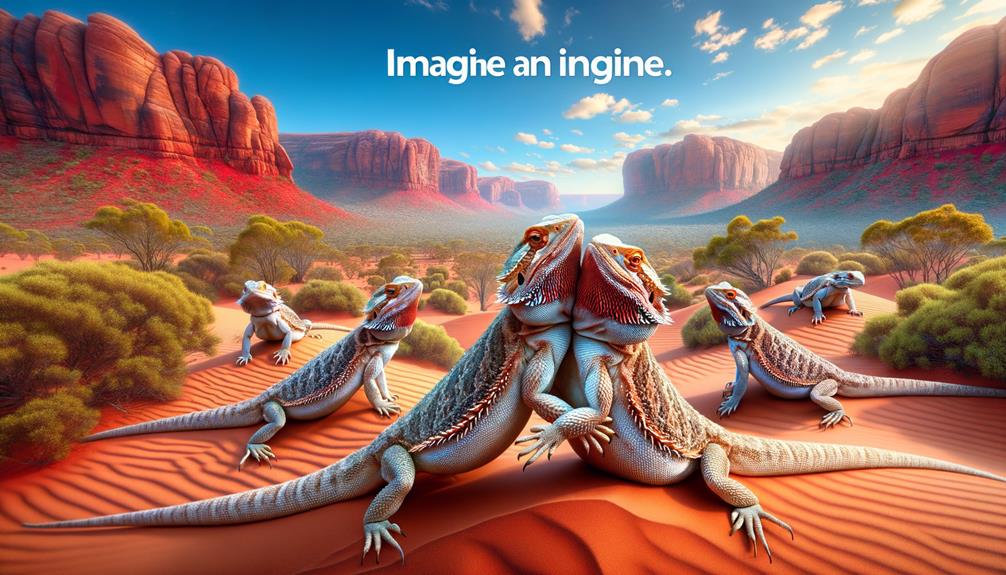
Central Bearded Dragons have some pretty wild mating habits. These lizards aren't into monogamy – instead, they're all about multiple partners and showing off. From September to March, male dragons put on quite a show. They bob their heads and puff out their beards, not just to look cool, but to mark their turf and scare off other guys.
These dragons know the importance of a good suntan, too. Males soak up the rays to get their bodies nice and warm, which helps them strut their stuff more effectively. When a female's interested, the male sidles up to her to get things started.
Female dragons have a neat trick up their sleeves – they can hold onto sperm from different males, mixing up the gene pool for their babies. After mating, they lay eggs that take about two to three months to hatch. When the little ones break out of their shells, they're ready to face the world on their own. This clever approach to reproduction helps these tough lizards thrive in the harsh Australian outback.
Conservation and Threats
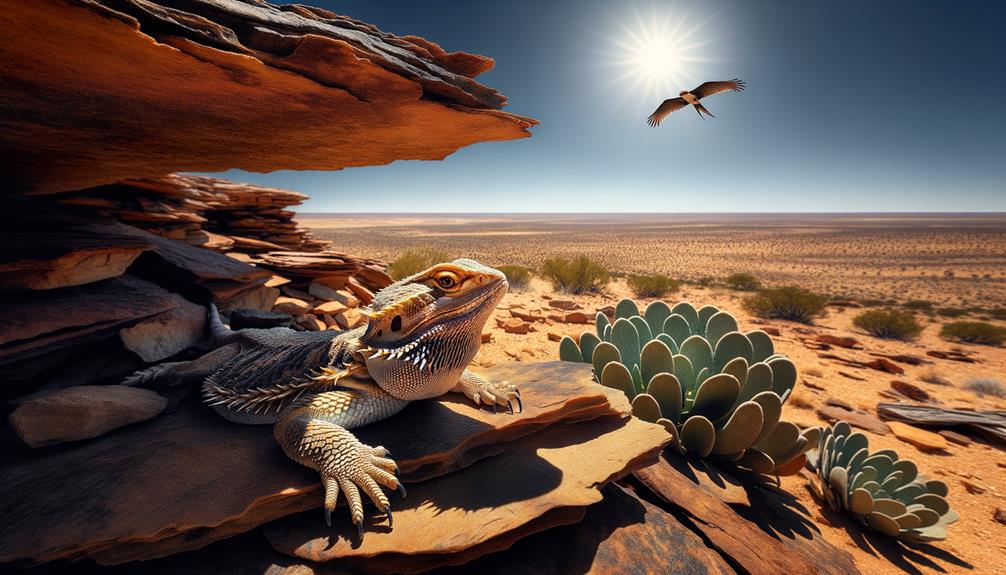
Central Bearded Dragons face a tough battle for survival. Their homes are vanishing as farms expand and cities grow, leaving them with less space to live, eat, and breed. It's not just humans causing problems – birds, snakes, and goannas hunt these lizards, making life even harder.
The pet trade adds another layer of trouble. People snatch these dragons from the wild, which not only reduces their numbers but also messes with their genetic mix. On top of that, parasites and mites make them sick and more vulnerable to other dangers.
But there's hope. Groups like Bush Heritage Australia are fighting back. They're working to:
- Save dragon habitats from destruction
- Keep feral predators in check
- Encourage native plants to grow
- Study dragon behavior and needs
- Get people interested and donating to help
These efforts are crucial. Without them, these unique lizards might disappear from the Australian landscape. It's a race against time, but with the right support, Central Bearded Dragons have a fighting chance.
Frequently Asked Questions
Where Are Central Bearded Dragons Found in Australia?
Central bearded dragons thrive in Australia's eastern interior, where semi-arid conditions dominate. You'll spot these hardy reptiles sunning themselves on rocky outcrops and sandy patches across western New South Wales and the Riverina region. Their presence in these harsh environments showcases their ability to adapt and survive in challenging conditions. These lizards have made themselves at home in the rugged landscape, seeking out warm spots and sheltered areas to regulate their body temperature and stay safe from predators.
Are Bearded Dragons Legal in Australia?
Bearded Dragons are indeed legal to keep as pets in Australia, but there's a catch. These reptiles fall under wildlife protection laws, which means you can't just go out and snag one from the wild. Each state has its own set of rules, so it's smart to check what applies where you live. You might need to get your hands on a permit, depending on local regulations. When you're ready to bring one home, make sure it's from a licensed breeder. This way, you're not only following the law but also supporting ethical pet ownership. Remember, a happy dragon makes for a happy owner!
When Did Australia Stop Exporting Bearded Dragons?
In 1963, Australia put a stop to Bearded Dragon exports. This move aimed to protect the species from potential harm. It paved the way for breeding programs in captivity, meeting global demand while safeguarding wild populations. The focus remains on treating these reptiles ethically.
The ban has had lasting effects. It ensured that Bearded Dragons in the pet trade come from carefully managed breeding programs, not from the wild. This approach helps maintain genetic diversity and prevents overharvesting of wild specimens.
Animal welfare groups have praised Australia's decision. They see it as a model for other countries dealing with exotic pet trade issues. The policy shows how conservation efforts can work alongside responsible pet ownership.
Today, Bearded Dragons are popular pets worldwide, thanks to successful breeding programs outside Australia. These programs have improved understanding of the species' needs and behaviors, benefiting both pet owners and researchers.
Do People in Australia Keep Bearded Dragons as Pets?
Bearded dragons have become popular pets in Australia. Known for their calm temperament and relatively simple care requirements, these reptiles appeal to many Aussie animal lovers. Their varied color patterns add to their charm. It's worth noting that bringing any pet into your home is a long-term commitment. Potential owners should consider the responsibilities involved in caring for these creatures throughout their lifespan, not just during the initial excitement of getting a new pet. Proper research and preparation are key to ensuring a happy, healthy life for these fascinating lizards.


